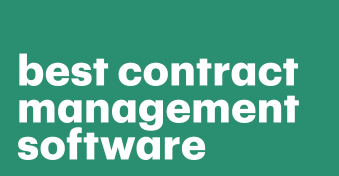Streamlining the proposal process is one of the fastest ways to expedite your sales workflow.
The ability to generate accurate proposals quickly allows reps to be more productive, connect with more customers, and win more business.
Fortunately, in the era of digital sales, multiple solutions exist to expedite proposal generation.
Today, we’ll look at two top-performing proposal generation solutions — Bidsketch and Proposify — to see what they offer and how they compare.
Let’s get started!
Key takeaways
- Bidsketch and Proposify generate proposals, but they use entirely different systems to do so.
- Proposify offers a wider selection of features particularly around integrations and e-signature solutions.
- Bidsketch is more cost effective, but it’s also more limited in customization and functionality.
Bidsketch
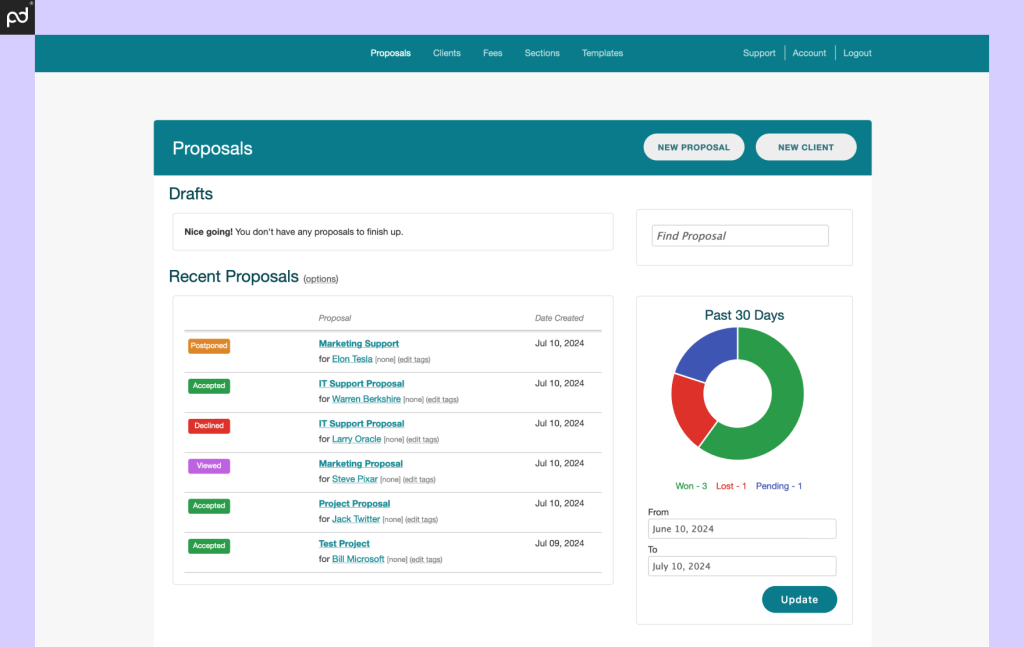
Pricing: Starter ($15); Solo ($23); Team Yearly ($47); Business Yearly ($119). Listed pricing based on annual commitment.
Ease of use: 4.5/5
Free trial: 14 days.
Support: Chat/email; knowledge-base.
Originally founded in 2009, Bidsketch has enjoyed substantial growth over its lifespan.
Today, the company boasts that it has helped companies win billions of dollars in business while saving thousands of hours throughout the proposal process.
The secret to Bidsketch’s success is its simplicity.
Rather than offering complex proposal tools with a ton of customization options, Bidsketch focuses almost exclusively on the automation and rapid production of sales proposals.
With that in mind, the backend of the Bidsketch engine is best described as a proposal compiler. Users place all relevant information into the appropriate text boxes, and the platform produces a formatted proposal at the end of the process.
This is different from the flexible, real-time document editors offered by competitors like Proposify and PandaDoc, where proposals are built in a live environment.
With Bidsketch, formatting and design are handled separately from content generation, creating a streamlined workflow that emphasizes ease of use rather than a Google Docs- or Microsoft Word-esque editing experience.
Proposify
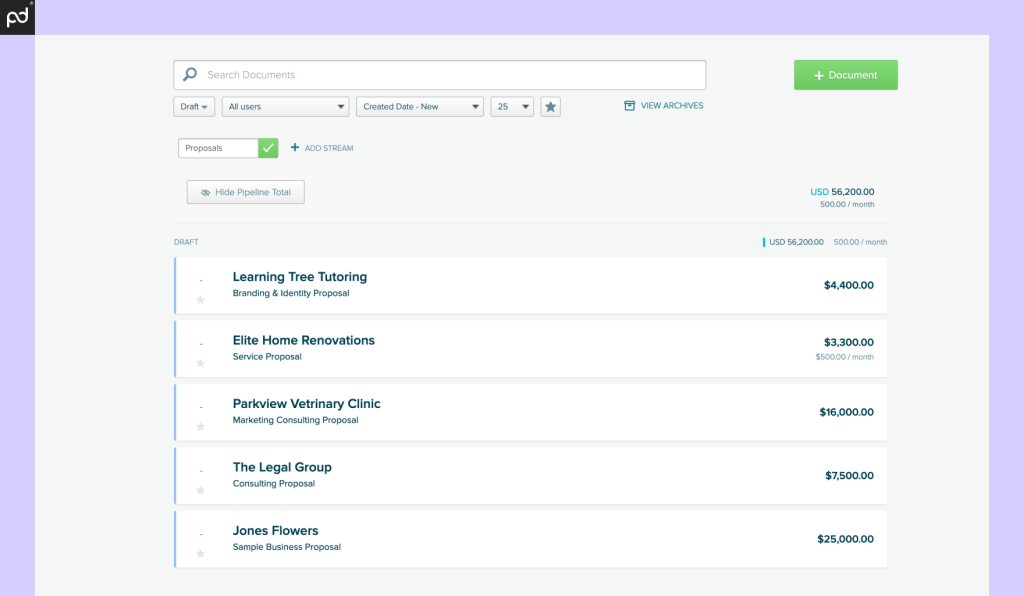
Pricing: Basic ($29); Team ($41); Business ($650). Business plan requires a 10 seat minimum. Pricing based on annual commitment.
Ease of use: 4.2/5
Free trial: 14 days.
Support: Email; chat; phone; knowledge base.
If we had to use one word to describe Proposify, it’s slick.
Everything about the platform, from its website to its document designer is equipped to look good and feel great to use.
That’s been a company motif since its inception in 2012, and that clear attention to detail has made the brand highly unique in the proposal market.
On the backend, Proposify is no slouch. The document builder is similar to PandaDoc and other competitors, offering project management for documents and near-total control over proposal design, format, and construction.
You’ll even find a payment collection protocol through Stripe and dedicated mobile apps for iOS and Android.
However, Proposify comes with something of a learning curve, especially if you’re just starting out.
The platform’s kitchen sink approach to bells and whistles can be overwhelming.
In some ways, it can feel like less of a proposal builder and signing solution and more like a professional design tool.
However, for users who want complete control over document generation, Proposify offers a proposal creation experience that is unrivaled by most competitors.
Proposify vs Bidsketch at a glance
We’ll dive deeper into the nuances between these two proposal solutions in the following sections, but here’s a closer look at how Bidsketch and Proposify compare at a high level.
| Feature | Proposify | Bidsketch |
|---|---|---|
| Proposal tools | Drag & drop | Compiler |
| E-signing | ✓ | Limited |
| Templates | ✓ | ✓ |
| Content library | ✓ | Limited |
| Custom domain | ✓ | ✓ |
| Custom branding | ✓ | ✓ |
| Payment gateways | Limited | X |
| CRM integrations | 2 | 2 |
| Document analytics | ✓ | ✓ |
| API access | X | ✓ |
| Customer Support | ||
| Email / ticketing | ✓ | ✓ |
| Chat support | Limited | Limited |
| Phone | $ | X |
| Success manager | $ | X |
| Onboarding services | $ | X |
While we’ll talk more about the differences in proposal tools a little farther down, there are a few things to note:
- Overall, Proposify offers a more interactive proposal experience.
- Bidsketch provides API access and unique flexibility around proposal templates.
- Both teams offer chat support, but it’s limited to business hours.
One final point: Proposify also offers onboarding and design services — for a cost. The onboarding flow is designed to help users move documents into Proposify.
Design services are available to help you get custom-designed proposals from designers who are familiar with the Proposify platform.
While these services are meant to ease the transition, it’s worth noting that most other proposal tools are intuitive/simple enough that such services aren’t needed in the first place.
Requirements, workflows & pricing
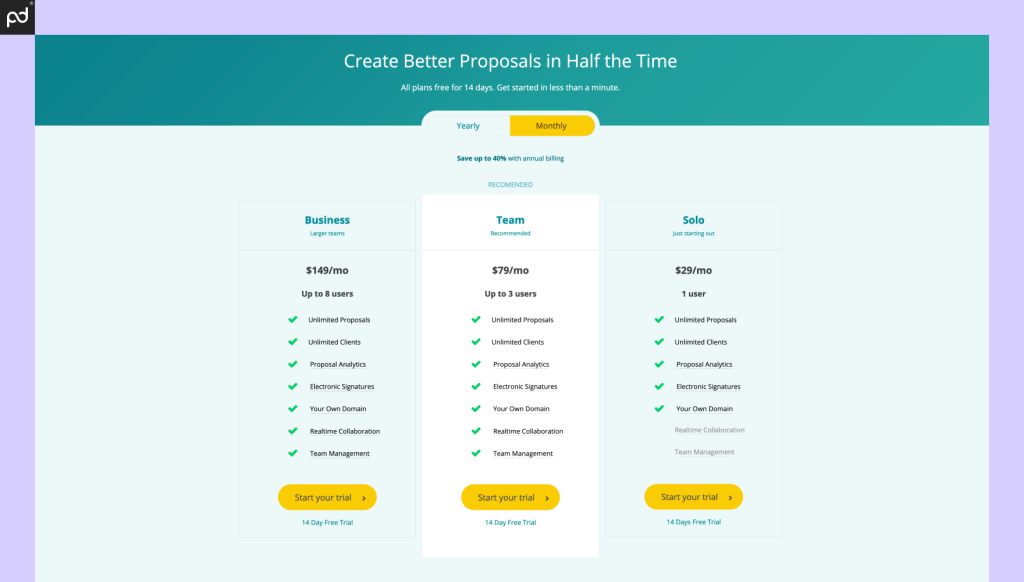
Because Bidsketch and Proposify are web-based platforms, all sales documents created are digital and easy to send.
This is a sea change for companies relying on Microsoft Word or similar desktop-based applications for proposal generation.
However, the workflow and pricing for both online proposal tools is very different.
Bidsketch users can get started by selecting a template from Bidsketch’s professionally designed library (similar to the PandaDoc template library).
While you can also create your own templates from scratch, the Bidsketch library is a great starting point.
Easily customize the template by adding your company’s branding, text, images, and pricing details. Bidsketch’s fee tables allow you to create detailed breakdowns of your services and costs.
Once the proposal is ready, you can send it to your client for review and feedback.
The platform also offers a limited, but native e-signing experience so that recipients can agree to proposal terms with ease.
In terms of pricing, Bidsketch is more cost effective than Proposify, but the platform has hard caps on the number of users for each plan.
The “Solo” plan is restricted to one user while the “Team” plan is restricted to three users, and the “Business” plan is capped at eight users.
Similar to Bidsketch, Proposify’s workflow involves selecting a template from a broad range categorized by industry and purpose. Building your own document from scratch is also an option.
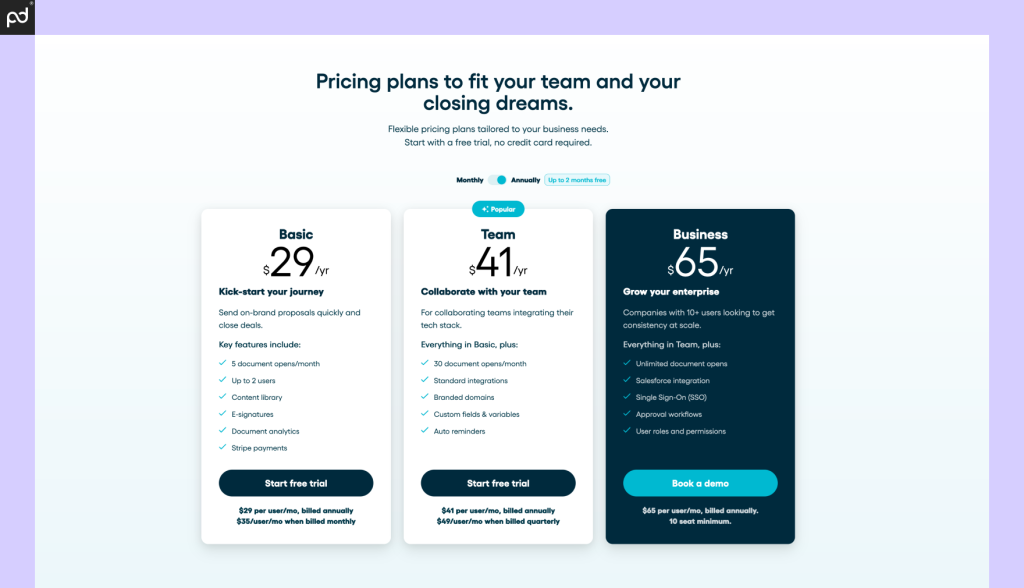
Proposify offers a drag-and-drop editor similar to PandaDoc. You’ll add text and multimedia blocks to a page, then add the appropriate content to those blocks. You can also include interactive pricing tables, videos, forms, and more.
Notably, once you’ve built a module that you like, Proposify’s content library gives you the ability to store and reuse that section again later, which helps you save time.
This platform also includes built-in e-signature functionality, so recipients can initial and sign off on proposal content during the review process.
In terms of pricing, Proposify costs more than Bidsketch but doesn’t restrict headcounts on most plans. The “Basic” plan caps at two users, while the “Business” plan requires a minimum of 10 users and acts as Proposify’s de facto enterprise plan.
However, Proposify does restrict the number of documents that can be opened per month. This is potentially more restrictive, especially because the counts are so low. “Basic” plan users are limited to five document opens per month, but this only improves to 30 opens/month on the Team plan.
Our suggestion
While both Bidsketch and Proposify will create professional proposals, you’ll have to decide which restrictions you want to live with when using the software.
If you’re under the headcount restrictions mandated by Bidsketch, the platform is more cost effective. Its turnkey approach to proposal creation will also be helpful for sales teams who need to manage and follow-up on proposals and RFP submissions.
Teams who want more control over the look and feel of their proposal will find Proposify more appealing. However, teams planning to send a high number of documents may find the opening restrictions to be something of a poison pill.
If that’s the case, we’d recommend taking a closer look at PandaDoc or another Proposify alternative. We offer a full-scope drag-and-drop editor with no transaction limits.
- Bidsketch offers better pricing and unlimited document opens, but less control over proposal design and output.
- Proposify provides a top-notch drag-and-drop editor, but restrictions around opens severely restrict usefulness.
- PandaDoc includes a flexible drag-and-drop editor with no restrictions around sends, opens, or signature capture.
Document creation & preparation
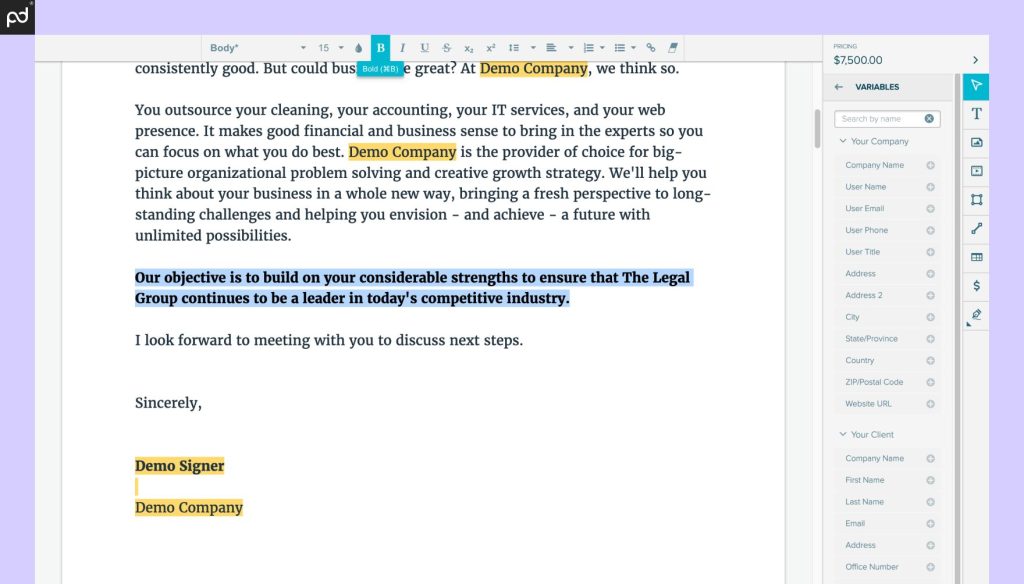
One of the major differences between Bidsketch and Proposify is how the proposal engine actually works.
The user experience varies greatly, as do the outputs that each platform will produce.
Proposify’s drag-and-drop editor is a real-time editing environment that is perfect for fine-tuning business proposals.
Users will drag blocks into the main document space and combine them to create a stunning document.
As the blocks are added, users can fill them using text, multimedia, and other interactive elements (like pricing tables) to the documents.
These elements can be easily rearranged by dragging and dropping or formatted using onboard tools.
Similar to PandaDoc, Proposify also features a content library enabling you to store and reuse common proposal sections across different projects.
However, the editor falls a little short when it comes to importing and attachments.
Unlike our own PandaDoc editor, which can seamlessly import .DOCX files and transform them into editable documents, Proposify can’t import any external document type.
Users will have to manually add text to the document via copy/paste and rebuild documents entirely from scratch within the Proposify editor in order to use them.
On the other hand, creating proposals with Bidsketch is an entirely different experience.
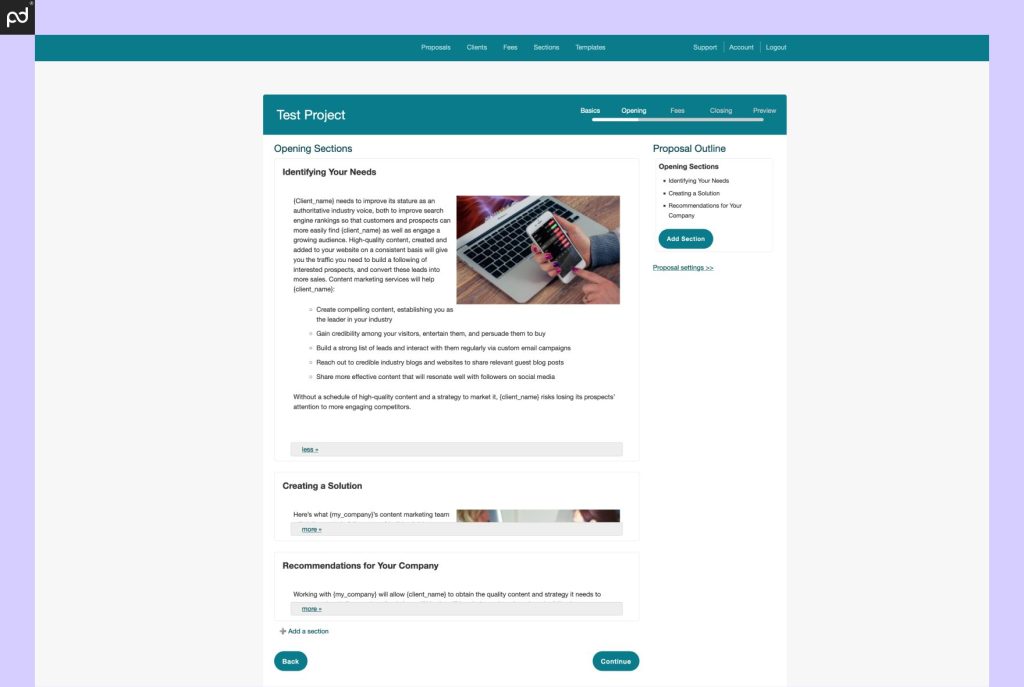
Bidsketch’s philosophy is that all proposals follow a similar layout broken broadly into three main sections: opening, fees, and closing.
Each section is created from multiple blocks that are compiled together to build a proposal. While this might sound counterintuitive, it’s no different from creating a document using different headings for each major section.
The key difference is that, using Bidsketch, you’ll need to build these blocks separately from your proposal and then add them to the appropriate section during the proposal creation process. The same is true for fees, which must first be created in the “Fees” section and then added to the proposal from the library.
The sections that Bidsketch provides are, in many ways, similar to the content library provided by PandaDoc or Proposify.
The key difference is that users need to build their sections and content blocks in the library first — independently of any proposal — and then add them during the proposal creation process.
However, unlike Proposify, this isn’t done visually. Users will select which blocks to add to the proposal outline. This creates a working skeleton of the proposal.
The actual document is only created at the end of the process, when all sections are compiled into a final output.
The end result is a proposal that follows a predictable style and format. It’s an effective approach, but users won’t have as much flexibility around layouts and customization.
Our suggestion
To determine which software is best suited to your needs, answer this question: How important is the design aspect of your proposals?
If you have sales reps who need to customize documents on the fly, or if sending complex proposals that are a cut above the rest is something that defines your organization, Proposify may be a better fit.
On the other hand, if you need to send as many proposals as possible and want almost nothing to do with content design, Bidsketch can get the job done.
- Proposify is ideal for teams where content design and branding plays a key role in the company’s CPQ or proposal strategy.
- Bidsketch will be sufficient for companies who don’t need all the design-related bells and whistles but still want to create great-looking content.
Sending, signatures & integrations

In recent years, most proposal solutions have expanded their functionality to further streamline the sales process.
This includes offering an electronic signature solution alongside proposal creation tools or integrating with a CRM like Salesforce to further integrate with an organizational tech stack.
From this perspective, the experience offered by Bidsketch and Proposify varies heavily.
Overall, Proposify offers more flexibility by way of integrations.
Within the Proposify integrations tab, you’ll find connections to CRMs like Salesforce and HubSpot.
Stripe is available for teams who want to collect payments with proposals. These integrations are great for small businesses looking to streamline their document workflow.
Using Proposify as a document management platform, it’s possible to connect proposals to a CRM on the front end and an accounting software like Quickbooks on the backend, with payment collection connected to the proposal itself.
This eliminates the need for dedicated invoicing and allows user activity to be tracked through audit trails and notifications.
Additionally, Proposify can act as a capable e-signature platform for proposals sent through its service.
Document recipients will be able to follow a simplified signing process that complies to both UETA and eIDAS standards (but isn’t HIPAA compliant).
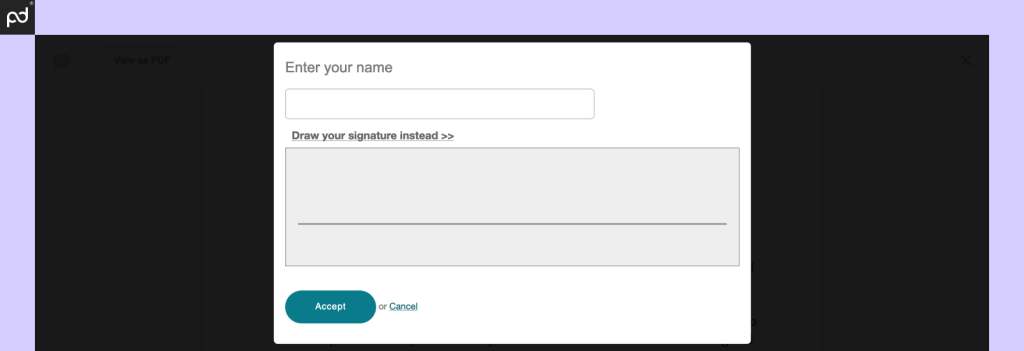
Unfortunately, building a complete workflow in Bidsketch simply isn’t an option.
The integrations and add-ons offered by Proposify, PandaDoc, and other proposal platforms feel like an afterthought within Bidsketch.
Strictly speaking, the platform does offer integration options with a limited number of apps.
This includes Zapier and Freshbooks, as well as SignWell (formerly Docsketch). You’ll also find a Salesforce integration, but it’s only available to users on the Team or Business plans.
While the limited selection of apps might feel spare, the platform does offer API access, which is something you won’t see with Proposify, and you won’t need to pay premium prices or subscribe to a premium plan in order to use it.
As an electronic signature software, Bidsketch falls remarkably short.
It’s possible for users to sign sent proposals, but the feature is hidden and lacks the integrated nuance that you’ll get when using platforms that focus heavily on the e-signing process.
Our suggestion
While Proposify offers a healthy selection of integrations by comparison to Bidsketch, this is a weak point for both platforms when compared to the rest of the market.
For example, PandaDoc offers 30+ native integrations with CRM, payment, and productivity tools. And that’s not including what connects through Zapier.
On top of that, e-signing is at the heart of the PandaDoc document process. The connectivity tools we provide are designed to create a fully paperless proposal experience and don’t require integration with third party e-signing solutions like DocuSign to achieve outstanding results.
We aren’t saying all that to brag, but it’s a major contrast to the limited options that are available in both of the software tools on offer.
- Proposify has a wider selection of integrations, which can be helpful for small businesses who want to consolidate proposals, CRMs, and payments into a single flow.
- Bidsketch has a limited collection of integrations but also offers API access, which could be helpful in a variety of use cases.
- Neither company offers the robust signing solutions and integration support that you’ll see with PandaDoc.
Bidsketch & Proposify alternative
No platform is perfect, and that’s definitely true when it comes to proposal software. Sometimes the feature set just isn’t what you need or the pricing plan doesn’t make sense.
If neither Bidsketch or Proposify resonate with you, here are a few other proposal providers you might consider:
- PandaDoc. (E-signing, document builder, storage support.)
- Qwilr. (Proposals built to resemble website landing pages.)
- GetAccept. (Deal rooms with integrated proposal tools.)
- Better Proposals. (Popular with freelancers.)
- dotloop. (Proposals and CRM for real estate.)
There are also business premium / business pro solutions out there targeted specifically as enterprise solutions.
Most of the time, these platforms integrate with cloud-based ERP solutions or offer API tools that you can use to expedite your workflow with their automations.
Signing solutions you might need
While it’s frustrating to consider, if you end up going with either platform, you may need more effective e-signing solutions than what Bidsketch and Proposify offer.
The onboard signing process is good enough for simple things, but if e-signing is a big sticking point, you may need to work with a dedicated tool like DocuSign or other alternatives like SignNow, Adobe Sign, or Dropbox Sign (formerly HelloSign).
Of course, PandaDoc also offers top-notch e-signing support if you want to keep your proposal and e-signing tools fully integrated.
If you need those solutions, we’d suggest checking out our popular articles on DocuSign pricing and DocuSign alternatives to get a better understanding of the e-signing landscape.

Build better documents with PandaDoc
While Bidsketch and Proposify are viable options for proposal generations, both platforms are missing key features that can further expedite your sales workflow.
This is especially true if you want a unified e-signing and proposal solution, or if you want to integrate your proposal platform with a robust selection of CRM tools or with PayPal rather than Stripe.
In our view, the best proposal management software is easy to navigate, useful for all users, and connects seamlessly with your tech stack. It should reduce your overall workload, not add to it.
PandaDoc has the tools and support you need to build a better document workflow. From a robust document builder to top-notch e-signing and security certifications, you’ll find everything you need to scale your business.
See how our software can work for you. Start your 14-day free trial today or request a demo to see a live demonstration.
Disclaimer
PandaDoc is not a law firm, or a substitute for an attorney or law firm. This page is not intended to and does not provide legal advice. Should you have legal questions on the validity of e-signatures or digital signatures and the enforceability thereof, please consult with an attorney or law firm. Use of PandaDocs services are governed by our Terms of Use and Privacy Policy.
Originally published May 8, 2020, updated August 14, 2024


